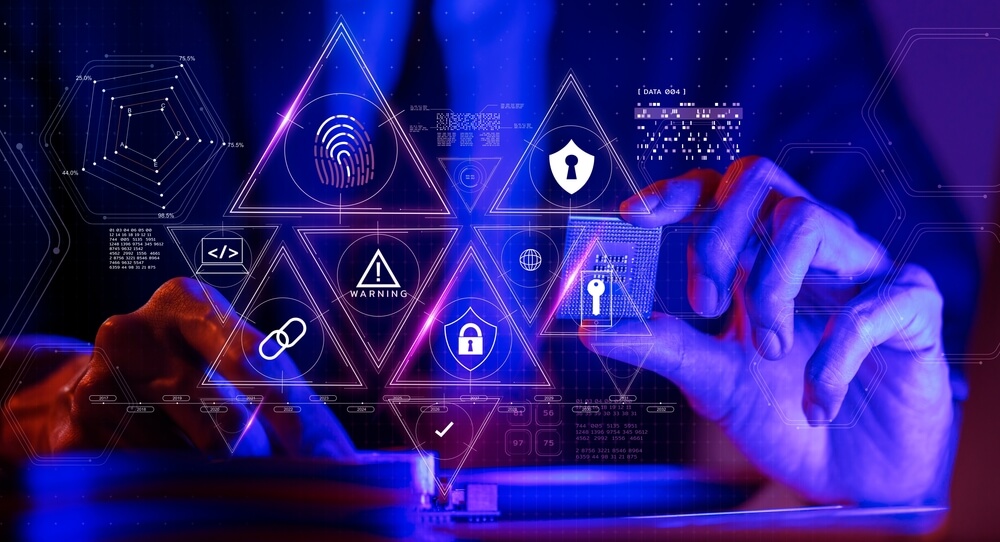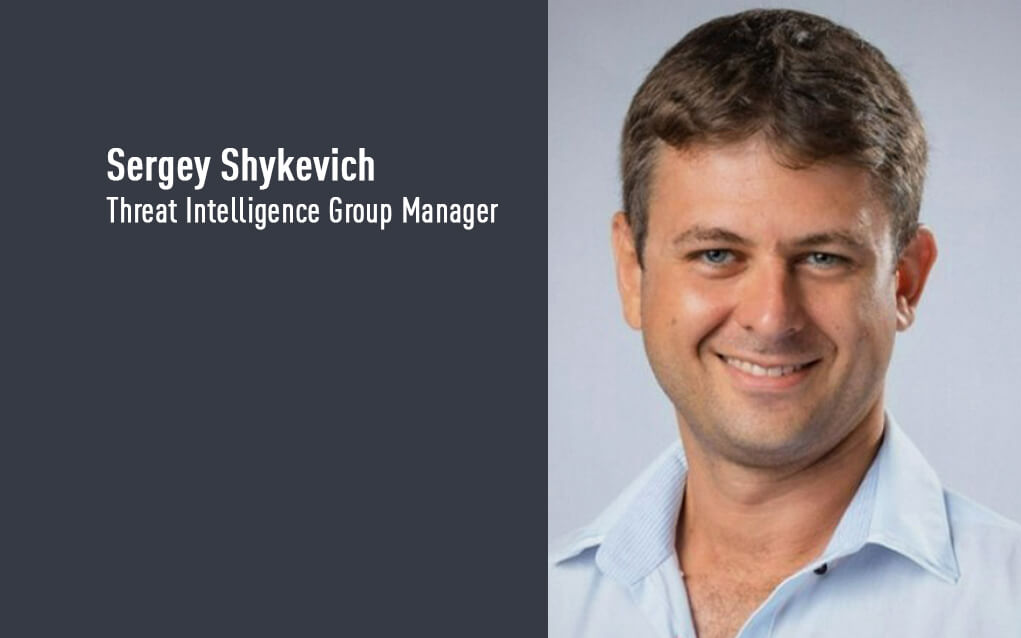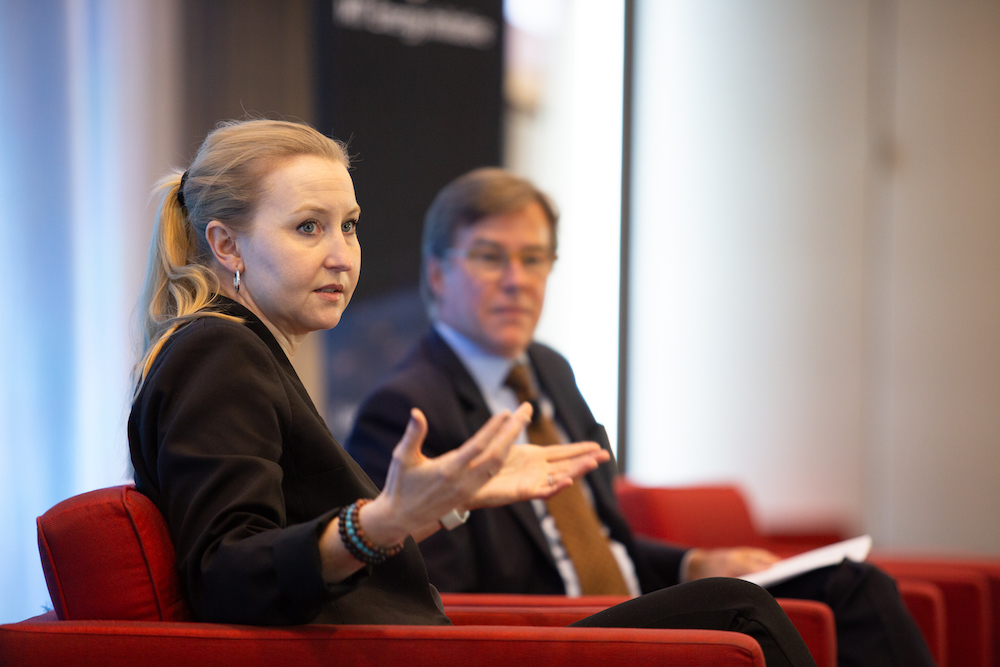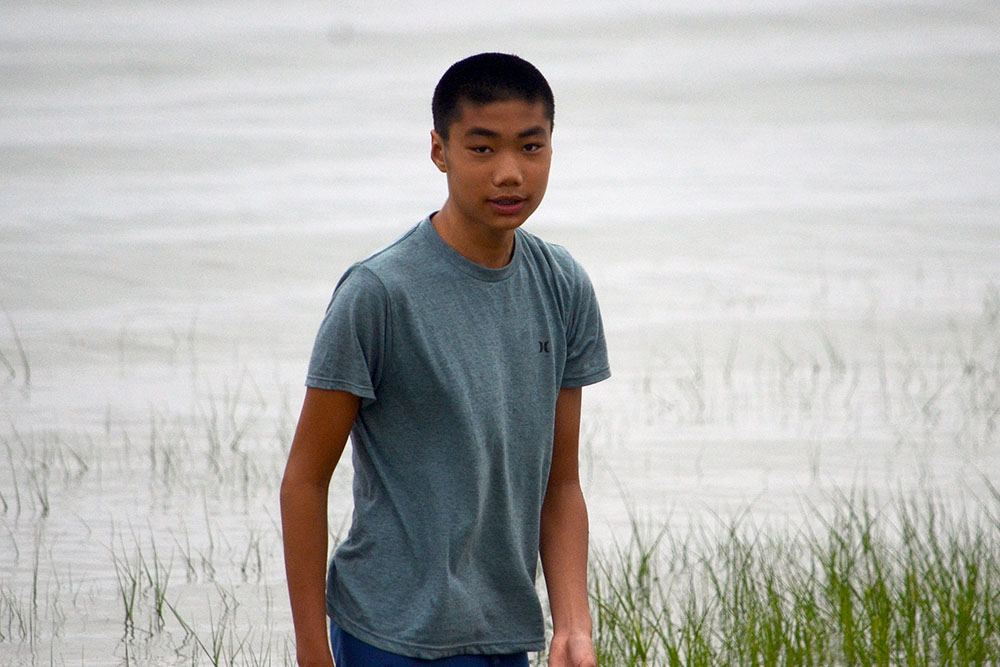The world in recent years has largely been moving on from debates about the need to curb carbon emissions and focusing more on action — the development, implementation, and deployment of the technological, economic, and policy measures to spur the scale of reductions needed by mid-century. That was the message Robert Stoner, the interim director of the MIT Energy Initiative (MITEI), gave in his opening remarks at the 2023 MITEI Annual Research Conference.
Attendees at the two-day conference included faculty members, researchers, industry and financial leaders, government officials, and students, as well as more than 50 online participants from around the world.
“We are at an extraordinary inflection point. We have this narrow window in time to mitigate the worst effects of climate change by transforming our entire energy system and economy,” said Jonah Wagner, the chief strategist of the U.S. Department of Energy’s (DOE) Loan Programs Office, in one of the conference’s keynote speeches.
Yet the solutions exist, he said. “Most of the technologies that we need to deploy to stay close to the international target of 1.5 degrees Celsius warming are proven and ready to go,” he said. “We have over 80 percent of the technologies we will need through 2030, and at least half of the technologies we will need through 2050.”
For example, Wagner pointed to the newly commissioned advanced nuclear power plant near Augusta, Georgia — the first new nuclear reactor built in the United States in a generation, partly funded through DOE loans. “It will be the largest source of clean power in America,” he said. Though implementing all the needed technologies in the United States through mid-century will cost an estimated $10 trillion, or about $300 billion a year, most of that money will come from the private sector, he said.
As the United States faces what he describes as “a tsunami of distributed energy production,” one key example of the strategy that’s needed going forward, he said, is encouraging the development of virtual power plants (VPPs). The U.S. power grid is growing, he said, and will add 200 gigawatts of peak demand by 2030. But rather than building new, large power plants to satisfy that need, much of the increase can be accommodated by VPPs, he said — which are “aggregations of distributed energy resources like rooftop solar with batteries, like electric vehicles (EVs) and chargers, like smart appliances, commercial and industrial loads on the grid that can be used together to help balance supply and demand just like a traditional power plant.” For example, by shifting the time of demand for some applications where the timing is not critical, such as recharging EVs late at night instead of right after getting home from work when demand may be peaking, the need for extra peak power can be alleviated.
Such programs “offer a broad range of benefits,” including affordability, reliability and resilience, decarbonization, and emissions reductions. But implementing such systems on a wide scale requires some up-front help, he explained. Payment for consumers to enroll in programs that allow such time adjustments “is the majority of the cost” of establishing VPPs, he says, “and that means most of the money spent on VPPs goes back into the pockets of American consumers.” But to make that happen, there is a need for standardization of VPP operations “so that we are not recreating the wheel every single time we deploy a pilot or an effort with a utility.”
The conference’s other keynote speaker, Anne White, the vice provost and associate vice president for research administration at MIT, cited devastating recent floods, wildfires, and many other extreme weather-related crises around the world that have been exacerbated by climate change. “We saw in myriad ways that energy concerns and climate concerns are one and the same,” she said. “So, we must urgently develop and scale low-carbon and zero-carbon solutions to prevent future warming. And we must do this with a practical, systems-based approach that considers efficiency, affordability, equity, and sustainability for how the world will meet its energy needs.”
White added that at MIT, “we are mobilizing everything.” People at MIT feel a strong sense of responsibility for dealing with these global issues, she said, “and I think it’s because we believe we have tools that can really make a difference.”
Among the specific promising technologies that have sprung from MIT’s labs, she pointed out, is the rapid development of fusion technology that led to MIT spinoff company Commonwealth Fusion Systems, which aims to build a demonstration unit of a practical fusion power reactor by the decade’s end. That’s an outcome of decades of research, she emphasized — the kinds of early-stage risky work that only academic labs, with help from government grants, can carry out.
For example, she pointed to the more than 200 projects that MITEI has provided seed funds of $150,000 each for two years, totaling over $28 million to date. Such early support is “a key part of producing the kind of transformative innovation we know we all need.” In addition, MIT’s The Engine has also helped launch not only Commonwealth Fusion Systems, but also Form Energy, a company building a plant in West Virginia to manufacture advanced iron-air batteries for renewable energy storage, and many others.
Following that theme of supporting early innovation, the conference featured two panels that served to highlight the work of students and alumni and their energy-related startup companies. First, a startup showcase, moderated by Catarina Madeira, the director of MIT’s Startup Exchange, featured presentations about seven recent spinoff companies that are developing cutting-edge technologies that emerged from MIT research. These included:
- Aeroshield, developing a new kind of highly-insulated window using a unique aerogel material;
- Sublime, which is developing a low-emissions concrete;
- Found Energy, developing a way to use recycled aluminum as a fuel;
- Veir, developing superconducting power lines;
- Emvolom, developing inexpensive green fuels from waste gases;
- Boston Metal, developing low-emissions production processes for steel and other metals;
- Transaera, with a new kind of efficient air conditioning; and
- Carbon Recycling International, producing cheap hydrogen fuel and syngas.
Later in the conference, a “student slam competition” featured presentations by 11 students who described results of energy projects they had been working on this past summer. The projects were as diverse as analyzing opposition to wind farms in Maine, how best to allocate EV charging stations, optimizing bioenergy production, recycling the lithium from batteries, encouraging adoption of heat pumps, and conflict analysis about energy project siting. Attendees voted on the quality of the student presentations, and electrical engineering and computer science student Tori Hagenlocker was declared first-place winner for her talk on heat pump adoption.
Students were also featured in a first-time addition to the conference: a panel discussion among five current or recent students, giving their perspective on today’s energy issues and priorities, and how they are working toward trying to make a difference. Andres Alvarez, a recent graduate in nuclear engineering, described his work with a startup focused on identifying and supporting early-stage ideas that have potential. Graduate student Dyanna Jaye of urban studies and planning spoke about her work helping to launch a group called the Sunrise Movement to try to drive climate change as a top priority for the country, and her work helping to develop the Green New Deal.
Peter Scott, a graduate student in mechanical engineering who is studying green hydrogen production, spoke of the need for a “very drastic and rapid phaseout of current, existing fossil fuels” and a halt on developing new sources. Amar Dayal, an MBA candidate at the MIT Sloan School of Management, talked about the interplay between technology and policy, and the crucial role that legislation like the Inflation Reduction Act can have in enabling new energy technology to make the climb to commercialization. And Shreyaa Raghavan, a doctoral student in the Institute of Data, Systems, and Society, talked about the importance of multidisciplinary approaches to climate issues, including the important role of computer science. She added that MIT does well on this compared to other institutions, and “sustainability and decarbonization is a pillar in a lot of the different departments and programs that exist here.”
Some recent recipients of MITEI’s Seed Fund grants reported on their progress in a panel discussion moderated by MITEI Executive Director Martha Broad. Seed grant recipient Ariel Furst, a professor of chemical engineering, pointed out that access to electricity is very much concentrated in the global North and that, overall, one in 10 people worldwide lacks access to electricity and some 2.5 billion people “rely on dirty fuels to heat their homes and cook their food,” with impacts on both health and climate. The solution her project is developing involves using DNA molecules combined with catalysts to passively convert captured carbon dioxide into ethylene, a widely used chemical feedstock and fuel. Kerri Cahoy, a professor of aeronautics and astronautics, described her work on a system for monitoring methane emissions and power-line conditions by using satellite-based sensors. She and her team found that power lines often begin emitting detectable broadband radio frequencies long before they actually fail in a way that could spark fires.
Admir Masic, an associate professor of civil and environmental engineering, described work on mining the ocean for minerals such as magnesium hydroxide to be used for carbon capture. The process can turn carbon dioxide into solid material that is stable over geological times and potentially usable as a construction material. Kripa Varanasi, a professor of mechanical engineering, said that over the years MITEI seed funding helped some of his projects that “went on to become startup companies, and some of them are thriving.” He described ongoing work on a new kind of electrolyzer for green hydrogen production. He developed a system using bubble-attracting surfaces to increase the efficiency of bioreactors that generate hydrogen fuel.
A series of panel discussions over the two days covered a range of topics related to technologies and policies that could make a difference in combating climate change. On the technological side, one panel led by Randall Field, the executive director of MITEI’s Future Energy Systems Center, looked at large, hard-to-decarbonize industrial processes. Antoine Allanore, a professor of metallurgy, described progress in developing innovative processes for producing iron and steel, among the world’s most used commodities, in a way that drastically reduces greenhouse gas emissions. Greg Wilson of JERA Americas described the potential for ammonia produced from renewable sources to substitute for natural gas in power plants, greatly reducing emissions. Yet-Ming Chiang, a professor in materials science and engineering, described ways to decarbonize cement production using a novel low-temperature process. And Guiyan Zang, a research scientist at MITEI, spoke of efforts to reduce the carbon footprint of producing ethylene, a major industrial chemical, by using an electrochemical process.
Another panel, led by Jacopo Buongiorno, professor of nuclear science and engineering, explored the brightening future for expansion of nuclear power, including new, small, modular reactors that are finally emerging into commercial demonstration. “There is for the first time truly here in the U.S. in at least a decade-and-a-half, a lot of excitement, a lot of attention towards nuclear,” Buongiorno said. Nuclear power currently produces 45 to 50 percent of the nation’s carbon-free electricity, the panelists said, and with the first new nuclear power plant in decades now in operation, the stage is set for significant growth.
Carbon capture and sequestration was the subject of a panel led by David Babson, the executive director of MIT’s Climate Grand Challenges program. MIT professors Betar Gallant and Kripa Varanasi and industry representatives Elisabeth Birkeland from Equinor and Luc Huyse from Chevron Technology Ventures described significant progress in various approaches to recovering carbon dioxide from power plant emissions, from the air, and from the ocean, and converting it into fuels, construction materials, or other valuable commodities.
Some panel discussions also addressed the financial and policy side of the climate issue. A panel on geopolitical implications of the energy transition was moderated by MITEI Deputy Director of Policy Christopher Knittel, who said “energy has always been synonymous with geopolitics.” He said that as concerns shift from where to find the oil and gas to where is the cobalt and nickel and other elements that will be needed, “not only are we worried about where the deposits of natural resources are, but we’re going to be more and more worried about how governments are incentivizing the transition” to developing this new mix of natural resources. Panelist Suzanne Berger, an Institute professor, said “we’re now at a moment of unique openness and opportunity for creating a new American production system,” one that is much more efficient and less carbon-producing.
One panel dealt with the investor’s perspective on the possibilities and pitfalls of emerging energy technologies. Moderator Jacqueline Pless, an assistant professor in MIT Sloan, said “there’s a lot of momentum now in this space. It’s a really ripe time for investing,” but the risks are real. “Tons of investment is needed in some very big and uncertain technologies.”
The role that large, established companies can play in leading a transition to cleaner energy was addressed by another panel. Moderator J.J. Laukatis, MITEI’s director of member services, said that “the scale of this transformation is massive, and it will also be very different from anything we’ve seen in the past. We’re going to have to scale up complex new technologies and systems across the board, from hydrogen to EVs to the electrical grid, at rates we haven’t done before.” And doing so will require a concerted effort that includes industry as well as government and academia.






